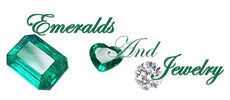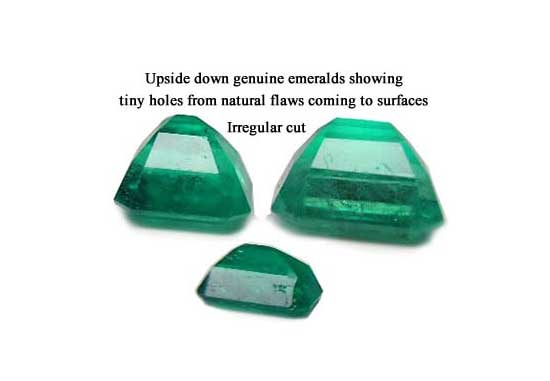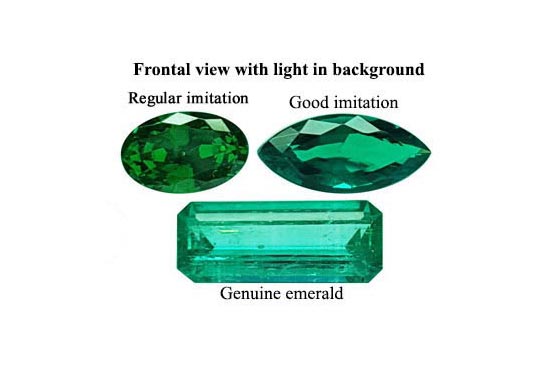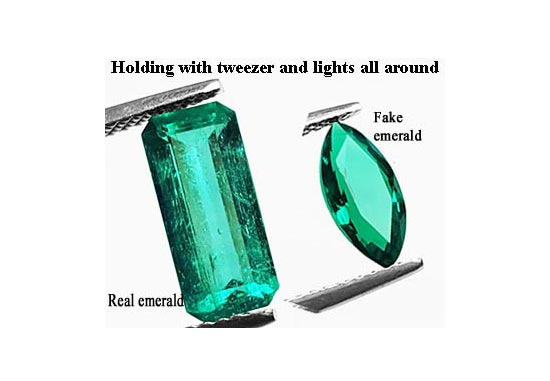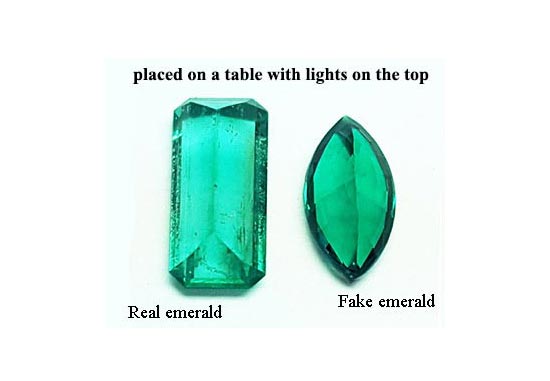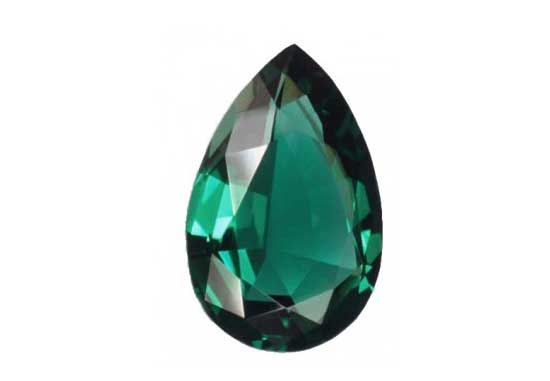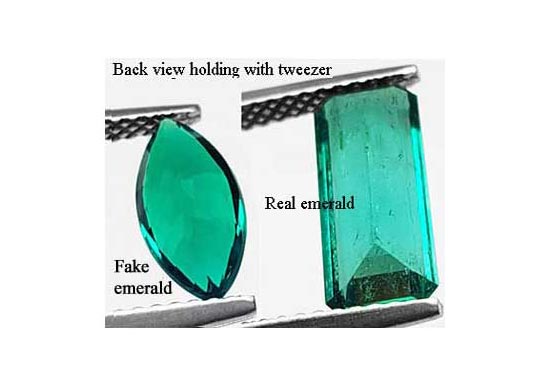How to Tell if an Emerald is Real or Fake Set of Images
Basic Tips and a wide set of comparative images with tags on how to tell if an emerald is real or fake for a person without any knowledge of emeralds; But if you are buying a high-priced emerald, it is better to get an independent lab report.
Real Emeralds Vs. Fake Emeralds:
GENUINE - NATURAL - REAL - AUTHENTIC - LAND BORN – EARTH MINED... have the same meaning.
The difference between a natural and a synthetic (or lab created) emerald can be difficult for the average person to determine. The following steps show how you can discover if an emerald is real or not:
Color, weight and temperature in real Emeralds are slightly different from the Lab Grown and other imitations, but a trained eye and knowledge of Dealer's experience is needed to determine these differences and here I try to help people who don't know about emeralds.
An emerald having a very vivid and intense shade of green; extremely clean with the same brilliant luster (shine) visible on a natural emerald of far greater quality (and cost!), and with a price tag of only USD $500 (or less) per carat, indicates that this is not a realistic price for a real natural emerald. When the price is suspiciously low, you are probably looking at a lab created emerald. Always ask if the emeralds you are looking at are created (Man-made) or natural.
If you are making a significant investment in a high-quality emerald, my advice is to have the gem tested at a reputable, independent laboratory; Lab grown emeralds are very similar to high quality natural ones; If there is already a lab report for the emerald being purchased, make sure it corresponds to the emerald you are going to buy.
Explained in an Emerald Ring for all Finished Emerald Jewelry:
Firmly grasp the emerald ring and make a very sharp inspection on the girdle of the gem looking for material fused together or assembled in layers If you don't have access to inspect the girdle and pavilion, I wouldn't buy the item, there is a lot of tricks like doublets made with the same material of emeralds with identical characteristics of them and color enhance in the mounting among many others. If you are buying a bezel setting emerald ring make sure it has access to the pavilion for inspection and further cleaning process.
Emerald doublets or any other man-made gem imitation in jewelry must be disclosed by the seller.
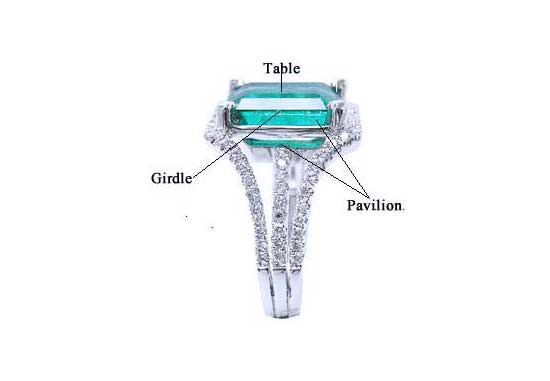
NORMALY A GENUINE EMERALD RING MUST BE SET WITH GIRDLE ON SIGHT AND VIEW ACCESS TO THE PAVILION
Never inspect an emerald ring or any other jewel without a X10 lope, if you don’t have one, ask the seller for a 10x lope or a good magnifying lens and a bright light. If you see tiny flaws or "irregular patterns" within the stone and (this is a very important detail) small natural holes or tiny deep lines especially in the pavilion (the backside) of the gemstone, this is an indication that it may be a natural emerald...Normally 90% of natural emeralds are left with small imperfections on the pavilion after being cut, due to the deep natural flaws that come to the surface, including irregular cut, because these natural imperfections are in the color area of the emerald, as the cut goes deeper into this area to remove the imperfections, the color fades. See graphs below.
The most desired shape is the emerald cut in engagement emerald rings. There are a lot of different styles and designs but always the girdle and pavilion of all gemstones must be exposed on sight (but not too high) for inspection and future cleaning procedures in all items. In bezel setting gemstones, the pavilion must be open at the bottom NOT CLOSED.
A SYNTHETIC GREEN LAYER FUSED BETWEEN TWO COLORLESS LAYERS OF AUTHENTIC VERYL OR EMERALD MATERIAL.
You can see the natural flaws and even natural holes because the material on both sides of the doublet are genuine colorless emerald layers, that is why the salesperson will tell you "THIS IS A REAL NATURAL GEM! on the front view it looks like a beautiful high quality emerald. So, it is very important to inspect the GIRDLE with a X10 lope looking for a possible assemblage.
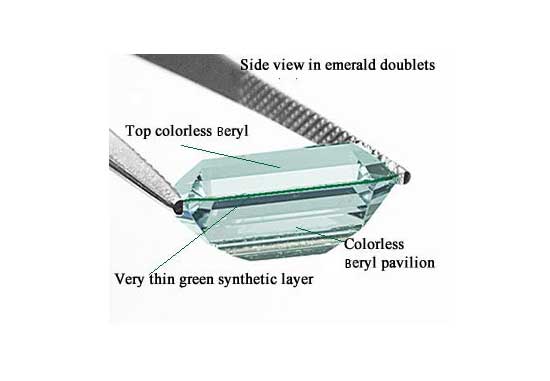

But also, there are emeralds and other color gemstones with a remarkable color zone...
COLOR ZONED IN NATURAL EMERALDS IS COMMON
This is a genuine Colombian emerald with a remarkable color zone which keeps its natural flaws in it, becoming natural holes and scratches on the surface of the pavilion, if more polish, less color, the color zone reaches the culet to make sure that the frontal view all color spreads to all the gemstone.
For an inexperienced eye this emerald could seem like a doublet, but it is not.
DON'T BE CONFUSED WITH REAL AND MAN-MADE EMERALDS:
Check the emerald pictures below
There are laboratories creating “green stones” OR IMMITATIONS, very similar in chemical composition to natural emeralds. These emeralds created in laboratories are so identical to the natural ones, some even include the apparent natural flaws inside of the stone. Jewelry stores may display these stones with different names such as “lab grown,” “Chatham,” “man made,” and “natural lab created” This imitation of “emeralds” can be larger, have nicer color, and contain fewer flaws than real mined ones and their composition may also be comparable to natural emeralds. However, the fact that their cost is usually a fraction of the price of the real natural mined emeralds. As is currently the case with "Lab Grown Diamonds"; because these "Lab grown stones" can be manufactured by the ton at low cost; Natural gems are not, and their extraction cost is very expensive, because they are not abundant.
